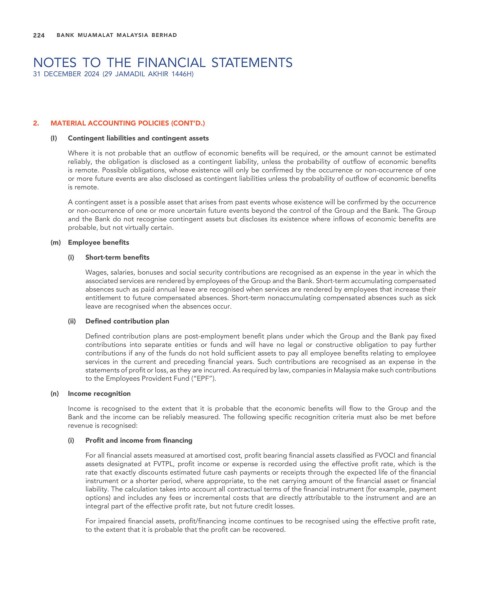Page 226 - Bank Muamalat_AR24
P. 226
224 BANK MUAMALAT MALAYSIA BERHAD
NOTES TO THE FINANCIAL STATEMENTS
31 DECEMBER 2024 (29 JAMADIL AKHIR 1446H)
2. MATERIAL ACCOUNTING POLICIES (CONT’D.)
(I) Contingent liabilities and contingent assets
Where it is not probable that an outflow of economic benefits will be required, or the amount cannot be estimated
reliably, the obligation is disclosed as a contingent liability, unless the probability of outflow of economic benefits
is remote. Possible obligations, whose existence will only be confirmed by the occurrence or non-occurrence of one
or more future events are also disclosed as contingent liabilities unless the probability of outflow of economic benefits
is remote.
A contingent asset is a possible asset that arises from past events whose existence will be confirmed by the occurrence
or non-occurrence of one or more uncertain future events beyond the control of the Group and the Bank. The Group
and the Bank do not recognise contingent assets but discloses its existence where inflows of economic benefits are
probable, but not virtually certain.
(m) Employee benefits
(i) Short-term benefits
Wages, salaries, bonuses and social security contributions are recognised as an expense in the year in which the
associated services are rendered by employees of the Group and the Bank. Short-term accumulating compensated
absences such as paid annual leave are recognised when services are rendered by employees that increase their
entitlement to future compensated absences. Short-term nonaccumulating compensated absences such as sick
leave are recognised when the absences occur.
(ii) Defined contribution plan
Defined contribution plans are post-employment benefit plans under which the Group and the Bank pay fixed
contributions into separate entities or funds and will have no legal or constructive obligation to pay further
contributions if any of the funds do not hold sufficient assets to pay all employee benefits relating to employee
services in the current and preceding financial years. Such contributions are recognised as an expense in the
statements of profit or loss, as they are incurred. As required by law, companies in Malaysia make such contributions
to the Employees Provident Fund (“EPF”).
(n) Income recognition
Income is recognised to the extent that it is probable that the economic benefits will flow to the Group and the
Bank and the income can be reliably measured. The following specific recognition criteria must also be met before
revenue is recognised:
(i) Profit and income from financing
For all financial assets measured at amortised cost, profit bearing financial assets classified as FVOCI and financial
assets designated at FVTPL, profit income or expense is recorded using the effective profit rate, which is the
rate that exactly discounts estimated future cash payments or receipts through the expected life of the financial
instrument or a shorter period, where appropriate, to the net carrying amount of the financial asset or financial
liability. The calculation takes into account all contractual terms of the financial instrument (for example, payment
options) and includes any fees or incremental costs that are directly attributable to the instrument and are an
integral part of the effective profit rate, but not future credit losses.
For impaired financial assets, profit/financing income continues to be recognised using the effective profit rate,
to the extent that it is probable that the profit can be recovered.

